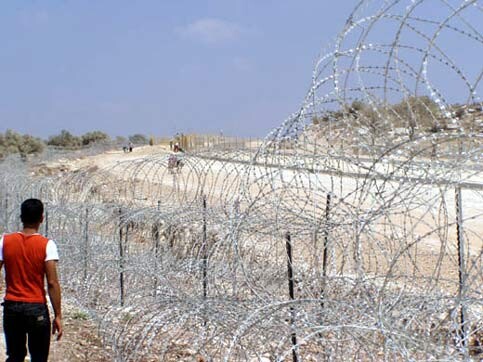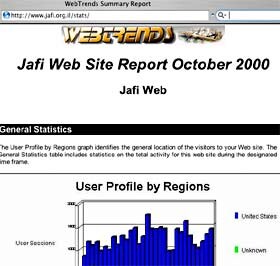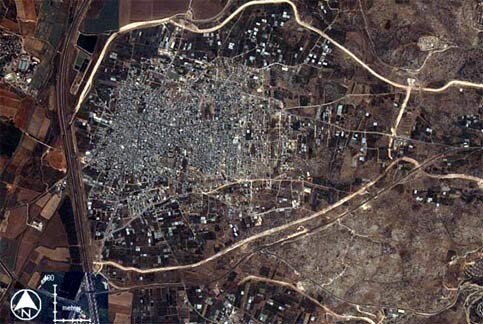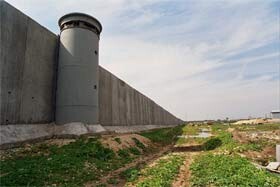The Electronic Intifada 4 March 2004

Jayyus, Qalqiliya, August 2003. (PENGON/Anti-Apartheid Wall Campaign)
In a presentation on the Jewish Agency for Israel’s website, entitled “The Security Fence - Hopes and Fears: A Drama in Six Episodes” — found at www.jafi.org.il/education/actual/conflict/fence/ — the report’s author, Steven Klein, conducted a December 2003 Google survey into the frequency of terminology used to describe Israel’s Wall, typing in different terms and logging the number of Google hits returned for each.
Klein’s stated methodology for discovering “the most deserving term” for Israel’s Wall is which term “enjoys the most common use” as evidenced by Google, a dubious quantity-oriented way of resolving semantic issues, particularly when one considers the number of online retailers worldwide selling “security fences” to homes and businesses that turn up in the results and whose current product catalogs do not feature any “Apartheid Walls”.
For the term “Separation Fence”, an article on EI’s site was returned as the first hit. Amazingly, Klein follows the entry from EI with the note: “Do not use this propaganda site from an unprotected computer — it will register your IP address.”
An expert on webservers thanks to his 10 minutes on Google, Klein apparently doesn’t realise that all webservers use IP addresses as the way they deliver pages to visitors. All but a handful of webservers on the planet by default maintain server logs which record IP addresses as a matter of course, as well as the time and date that each file was requested. The purpose of this is to provide webmasters with an overview of general visitor patterns in order to gauge a site’s success and avoid server overloads during busy periods, identify popular areas of the site to develop further, discover broken links, and a variety of other banal administrative functions.
None of this logging personally identifies any visitor but rather anonymously tracks what are essentially the website’s “Greatest Hits”. Webserver logs on high traffic sites like EI see millions of lines added each week and are deleted every few months to conserve space.
The very notion that any maintainers of a news website based in the United States would have the inclination to violate the privacy of their site’s visitors who they are trying to encourage to return or — most pertinently — would have access to ISP customer records in order to match IP addresses with real names is plainly silly. EI is not the FBI, just a small group of people running an information site on a total budget one can be sure is less than Klein’s annual salary.

The webserver statistics program on the Jewish Agency’s website.
Most webserver statistic programs output their results to a URL on the site whose statistics are being measured. Through guessing common URLs for standard statistics programs, EI was able to browse an October 2000 archive of webserver statistics for the Jewish Agency website on which the article was published. The statistics include a “unique users” statistic, a measurement impossible without the same logging of IP addresses that Klein portrays as insidious.
The final irony is found in Klein’s playing on “security” fears to discourage visitors from seeing EI’s site for themselves, which parallels Israel’s use of the same argument to stop people looking closely at what Israel’s barrier actually does on the ground.
In any case, it is instructive to see what usage the various terms for the Wall are currently returning on Google since Klein’s article was published on 24 December 2003.
| Term used to describe barrier | Klein’s Google Search, 24 December 2003 | % | EI’s Google Search, 2 March 2004 | % |
| Security Fence | 25,300 | 29 | 92,300 | 32 |
| Security Barrier | 14,100 | 16 | 41,900 | 14 |
| Apartheid Wall | 13,300 | 15 | 44,600 | 15 |
| Security Wall | 12,300 | 14 | 40,400 | 14 |
| Separation Wall | 8,730 | 10 | 30,800 | 11 |
| Separation Barrier | 7,330 | 8 | 17,500 | 6 |
| Separation Fence | 5,990 | 7 | 19,300 | 7 |
| Terror Prevention Fence | n/a | n/a | 664 | n/a |
| Anti-Terrorist Fence | n/a | n/a | 1,050 | n/a |
| Totals | 87,050 | 290,800 (+334%) |
Note: Google is an extremely active search engine, indexing large numbers of new webpages and deleting dead links from its database each day. Results for search terms above will vary considerably over time.
What is interesting about the new statistics is that, despite a 334% increase of indexed pages mentioning the various terms for Israel’s wall in the last two months, there have been no significant changes in the relative usage of one term compared to another. The exceptions are the two new terms at the bottom of the table (not included in totals or percentages) which demonstrate that Israeli government terminology — particularly when as misleadingly perjorative as that which it has attempted to introduce into common usage for the Wall — does not catch on as easily as one might assume.
In this battle over what to call Israel’s Wall, some things have become clear about some of the terms that appear above.
“Fence” vs. “Wall”
The structure includes both fence and wall components, sometimes a mix of both. As such it is neither definitively one nor the other. In the past EI has emphasised the term “Wall”, as those significant areas where the structure is a wall — such as where it surrounds the entire Palestinian city of Qalqiliya or Jerusalem — achieve a barbaric aim. In the case of Qalqiliya, the Wall beseiges an entire population within the city limits, with just one exit, regularly and arbitrarily closed. Confined to an almost entirely urban area prevents residents from accessing the vast majority of their life-sustaining agricultural land outside the wall.

This satellite image of Qalqilya and the Wall surrounding the city was taken on 7 June 2003. (Space Imaging Eurasia)

The Wall around Qalqiliya. A twenty-five foot high concrete cage cuts residents off from their agricultural land, necessary for their survival, and prevents you from traveling even 5 minutes out of the City. A single gate, open at the whims of the occupying army, controls 100,000 residents. (PENGON/Anti-Apartheid Wall Campaign)
Browsing the various Israeli government websites created to justify the barrier, it becomes quickly apparent that Israel is doing everything it can to avoid use of the term “wall”. On none of Israel’s sites could EI locate a single photograph of any of the massive wall sections of the barrier.
“Security” and “Separation”
Israel’s primary argument for the barrier is that it will bring security to Israeli civilians. While this is arguable to a degree on some simplistic theoretical levels such as it being harder for a potential suicide bomber to cross a 25-foot-high structure, there are two pertinent facts that undermine this claim.
The first fact is that the barrier is almost exclusively built on Palestinian West Bank land which — in a century-long conflict over land — is hardly likely to improve relations or the situation of the Palestinians, and therefore security. The barrier is itself a massive violation of the Fourth Geneva Convention of 1949 which requires occupying forces to treat civilians “humanely”. Among a long list of human rights violations, the barrier inhumanely consolidates Israel’s illegal colonisation of Palestinian territory, prevents Palestinians from accessing schools, hospitals, and land necessary for their survival, and at many other levels represents the exact opposite of the Convention, which exists to protect civilian populations during times of war. Violations of the Convention are considered war crimes under international law.
The second fact, which undermines characterisations of the barrier as a structure of “separation”, is that much of the structure is built deep into West Bank land, 10 miles deep at some point. What is significant about this fact is that somewhere in the region of 20% of the Palestinian population of the West Bank will be isolated on the Israeli side of the barrier. If the goal of the barrier was truly “separation” this would blatantly not be the case.
“Israel’s Apartheid Wall”, while a pejorative term, is used by Palestinians because it legitimately communicates the impenetrability and permanency of the structure in all its various forms, points to the clear discrimination evident in the treatment of Israelis versus Palestinians trying to cross through it, underlines that only Palestinians are paying the price in land for it, and because the ghettos of Palestinian communities created between the Israel-West Bank border and the Wall, and in other areas such as Qalqiliya and East Jerusalem represent a powerful historical echo of the bantustan and associated permit system that White South Africa imposed on its black population.
When one additionally notes that 50% of the West Bank is to be effectively annexed by the Wall, leaving Palestinian Arabs cut off from each other in a dramatically segmented 11% of their historic homeland while the Jewish state controls the remaining 89%, describing the barrier as serving an “Apartheid” function is less a matter of opinion than a simple comparative observation. And hopefully a wake-up call to a world that has stood by passively or approvingly while this crime has taken place in plain sight.
“Israel’s West Bank Barrier” is perhaps the most neutral term one would hope slips into common usage to fairly describe the structure, assuming our primary goal as an international community — when witnessing massive violations of human rights and regional threats to international peace and security — is to be more careful about what we call the realities on the ground rather than what we do about them.
Related Links
Nigel Parry is one of the founders of the Electronic Intifada.




